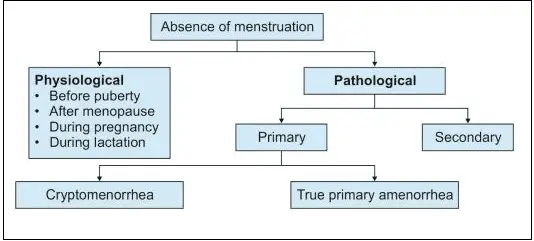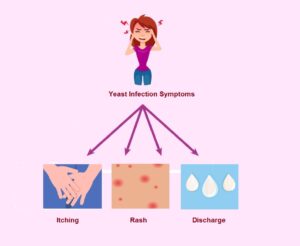Amenorrhea means the absence of menstrual periods in women of reproductive age.
Menstrual cycles, commonly known as the menstruation, are the month-by-month process by which the body gets ready for conception. Menstrual periods are a normal component of this cycle.
The menstrual cycle is regulated by hormones produced by the pituitary gland, the ovaries, and the adrenal glands.
Lack of periods may be normal at certain periods in a woman’s life, for example, during pregnancy, during breastfeeding, before attaining puberty and after the menopause. This is known as physiological amenorrhea
But in most cases, amenorrhea is due to an underlying pathological cause. This is known as pathological amenorrhea.
Types of Amenorrhea
There are two types of Amenorrhea:
Primary Amenorrhea – Primary amenorrhea is the absence of menstrual periods and the failure of development of secondary sexual characteristics by the age of 16 in the absence of any medical or surgical intervention. Secondary sexual characteristics include breast development, growth of hair in the armpits and pubic area, change in the voice and a build up of typical female pattern of body fat. The cause is usually chromosomal or developmental. The reproductive tract may fail to develop normally in these conditions.
Secondary amenorrhea – This means the absence of menstrual periods in a woman who has previously had periods. In women with regular periods, the absence of 3 consecutive cycles is termed amenorrhea. In women with irregular cycles, the absence of 6 consecutive cycles is said to be amenorrhea.

Causes of Amenorrhea
Amenorrhea can be caused by a variety of factors.
Hormonal Imbalances
Low amounts of oestrogen or high levels of androgens (male hormones) can result in amenorrhea. These imbalances can be caused by a variety of factors, including certain medical conditions, medications, or lifestyle factors.
Polycystic Ovarian Syndrome (PCOS)
PCOS is a hormonal condition that can lead to missed periods or irregular menstrual cycles. High testosterone levels, insulin resistance, and the appearance of tiny cysts on the ovaries are its defining characteristics.
Thyroid Issues
Menstrual cycles can be affected by hypothyroidism (an underactive thyroid) and hyperthyroidism (an overactive thyroid).
Anatomical Defects
Amenorrhea can be brought on by structural issues with the reproductive system, such as uterine fibroids or a congenital lack of the uterus.
Uterine Scarring
Asherman’s syndrome, a condition in which scar tissue builds up in the lining of the uterus, can sometimes occur after a dilation and curettage (D&C), cesarean section or treatment for uterine fibroids. The normal growth and shedding of the uterine lining are affected by uterine scarring.
Extreme Weight Gain or Loss
Extreme weight increase or loss might interfere with menstrual cycles and result in amenorrhea. Marathon runners or ballet dancers can often find their periods getting delayed or irregular.
Eating Disorders
Women with eating disorders like anorexia and/or bulimia may develop amenorrhea. This is because the body weight can get too low to sustain a normal menstual cycle. So to protect the body, the reproductive system “shuts down” because it’s severely malnourished.
Stress
Stress, both physical or mental is an important and common cause of loss of periods.
Certain Drugs
Some drugs, including blood pressure pills, antipsychotics, and antidepressants, might result in amenorrhea.
Premature Menopause
Menopause usually begins around age 50. But, for some women, the ovarian supply of eggs diminishes before age 40 and menstruation stops.
Pituitary Conditions
A noncancerous (benign) tumor in the pituitary gland can interfere with the hormonal regulation of menstruation. There may be an increase of prolactin ( hyperprolactinemia) which may be due to a tumor or due to unknown causes. Hyperprolactenemia is known to cause loss of periods.
Sheehans Syndrome
Sheehan’s syndrome (SS) is a kind of postpartum hypopituitarism brought on by pituitary necrosis. It typically results from severe hypotension or shock brought on by significant bleeding during or after delivery. Different levels of anterior pituitary hormone insufficiency are present in SS patients.
Symptoms
The primary symptom of amenorrhea is the absence of menstrual periods. But, depending on the underlying cause, there can be additional symptoms.
- Infertility – Depending on the underlying reason of amenorrhea, a woman may suffer from infertility and getting pregnant can be difficult or impossible.
- Hot flashes – Some amenorrheic women may suffer hot flashes. Hot flashes are sudden and abrupt sensations of heat that cause a reddening of the skin and sweating.
- Vaginal dryness– Amenorrhea can result in less oestrogen being produced, which can make the vagina dry and uncomfortable during sex.
- Changes in growth of body hair – Amenorrhea can alter the growth of body hair, resulting in changes like increased facial or body hair growth or thinning of the scalp hair.
- Breast Changes– There may be breast changes including smaller breasts or decreased milk output. Hyperprolactinemia can cause leakage of milk from the breasts.
- Mood Swings – mood swings like irritation, anxiety, or depression can occur

Diagnosis
- Family History – The first step in diagnosing amenorrhea is a thorough family history to identify any possible cause in the family which may cause amenorrhea.The medical history, eating and exercise habits, and any medicines or supplements will be noted.
- Menstrual history, including regularity of the periods, duration of the periods and the amount of blood flow are important diagnostic factors. The date of the last period is important.
- Blood tests. These check the levels of several hormones in the blood, such as prolactin, thyroid-stimulating hormone, follicle-stimulating hormone (FSH), and male hormones. The menstrual cycle may be affected by these hormones either because they are too high or because they are insufficient.
- Imaging Tests – These examinations can identify tumour sites or reproductive organ abnormalities. The examinations consist of magnetic resonance imaging (MRI), computed tomography (CT), and ultrasound (MRI).
- Hormone Challenge Test – The doctor may prescribe a hormone (progesterone) that, when stopped, should result in menstrual bleeding. If the menstrual bleeding does not occur, this can indicate that the amenorrhea is caused by a lack of oestrogen.
Treatment of Amenorrhea
Treatment of Amenorrhea is as per the cause:
- Hormonal therapy: If hormonal imbalances are the cause of amenorrhea, treatment may involve taking medications to get the hormone levels back to normal. This could include using birth control pills to control menstruation or other hormone replacement therapies to treat diseases like PCOS or hypothyroidism.
- Lifestyle Changes: Certain adjustments to one’s way of life, such as weight loss, increased physical activity, or stress reduction, may assist in regularizing the menstrual cycle.
- Surgery: Surgery may be needed to correct structural problems in the reproductive system that are causing amenorrhea, Surgery might be required to remove uterine fibroids or to correct a structural issue with the uterus or fallopian tubes.
- Fertility Treatments: If amenorrhea is the cause of infertility, fertility therapies such as Assisted Reproduction (ART) may be needed.
Prevention
In some cases, it may be possible to prevent amenorrhea or to reduce the risk of developing amenorrhea.
Maintain a healthy weight: Amenorrhea can result from being either underweight or overweight, which can interfere with the menstrual cycle. Amenorrhea can be avoided by maintaining a healthy weight with a balanced diet and regular exercise.
Avoid Excessive exercise: Regular exercise is vital for overall health, but excessive exercise can cause amenorrhea and interfere with the menstrual cycle. It’s critical to strike a balance and avoid overtraining.
Avoid stress: Excessive stress can impair the menstrual cycle and cause amenorrhea. It can be avoided by using stress management techniques like meditation or counselling.
Avoid smoking and alcohol: These can cause amenorrhea by interfering with the menstrual cycle.
It’s important to speak with a healthcare provider there is amenorrhea or any other changes in the menstrual cycle, as it can be a symptom of an underlying medical condition.
Read Questions and Answers on Pregnancy and Gynecology

Prenatal Vitamins – Why they are important
Prenatal Vitamins helps development of the baby and ensures a healthy pregnancy

How are Genital Warts treated?
Genital Warts are caused by the Human Papilloma Virus (HPV) and is one of the most common sexually transmitted diseases.

Pregnancy care in Guwahati: What to Expect
Pregnancy care involves caring for both the pregnant mother as well as the unborn baby in the uterus.

I think I have a yeast infection
I think I have a yeast infection. I had vaginal itching earlier and it is itching again now. What should i do?

I think I have Bacterial Vaginosis
I think I have bacterial vaginosis. I have a vaginal discharge with a fishy odor since the last few days. When should I see a doctor?

I am in early pregnancy and have dark brown discharge
Early pregnancy bleeding. What is wrong with me? What should I do?







